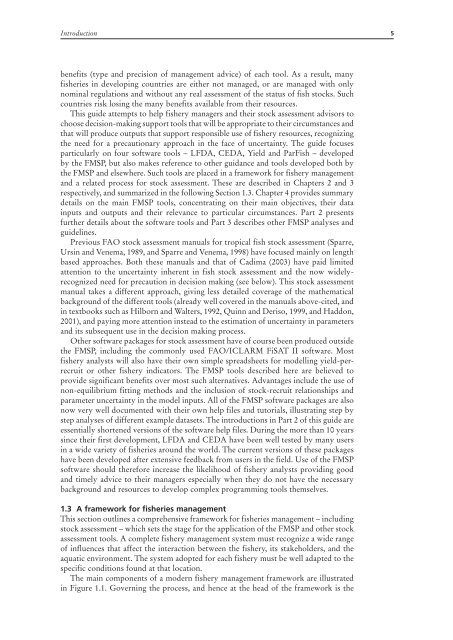Stock assessment for fishery management - Library
Stock assessment for fishery management - Library
Stock assessment for fishery management - Library
You also want an ePaper? Increase the reach of your titles
YUMPU automatically turns print PDFs into web optimized ePapers that Google loves.
Introductionbenefits (type and precision of <strong>management</strong> advice) of each tool. As a result, manyfisheries in developing countries are either not managed, or are managed with onlynominal regulations and without any real <strong>assessment</strong> of the status of fish stocks. Suchcountries risk losing the many benefits available from their resources.This guide attempts to help <strong>fishery</strong> managers and their stock <strong>assessment</strong> advisors tochoose decision-making support tools that will be appropriate to their circumstances andthat will produce outputs that support responsible use of <strong>fishery</strong> resources, recognizingthe need <strong>for</strong> a precautionary approach in the face of uncertainty. The guide focusesparticularly on four software tools – LFDA, CEDA, Yield and ParFish – developedby the FMSP, but also makes reference to other guidance and tools developed both bythe FMSP and elsewhere. Such tools are placed in a framework <strong>for</strong> <strong>fishery</strong> <strong>management</strong>and a related process <strong>for</strong> stock <strong>assessment</strong>. These are described in Chapters 2 and 3respectively, and summarized in the following Section 1.3. Chapter 4 provides summarydetails on the main FMSP tools, concentrating on their main objectives, their datainputs and outputs and their relevance to particular circumstances. Part 2 presentsfurther details about the software tools and Part 3 describes other FMSP analyses andguidelines.Previous FAO stock <strong>assessment</strong> manuals <strong>for</strong> tropical fish stock <strong>assessment</strong> (Sparre,Ursin and Venema, 1989, and Sparre and Venema, 1998) have focused mainly on lengthbased approaches. Both these manuals and that of Cadima (2003) have paid limitedattention to the uncertainty inherent in fish stock <strong>assessment</strong> and the now widelyrecognizedneed <strong>for</strong> precaution in decision making (see below). This stock <strong>assessment</strong>manual takes a different approach, giving less detailed coverage of the mathematicalbackground of the different tools (already well covered in the manuals above-cited, andin textbooks such as Hilborn and Walters, 1992, Quinn and Deriso, 1999, and Haddon,2001), and paying more attention instead to the estimation of uncertainty in parametersand its subsequent use in the decision making process.Other software packages <strong>for</strong> stock <strong>assessment</strong> have of course been produced outsidethe FMSP, including the commonly used FAO/ICLARM FiSAT II software. Most<strong>fishery</strong> analysts will also have their own simple spreadsheets <strong>for</strong> modelling yield-perrecruitor other <strong>fishery</strong> indicators. The FMSP tools described here are believed toprovide significant benefits over most such alternatives. Advantages include the use ofnon-equilibrium fitting methods and the inclusion of stock-recruit relationships andparameter uncertainty in the model inputs. All of the FMSP software packages are alsonow very well documented with their own help files and tutorials, illustrating step bystep analyses of different example datasets. The introductions in Part 2 of this guide areessentially shortened versions of the software help files. During the more than 10 yearssince their first development, LFDA and CEDA have been well tested by many usersin a wide variety of fisheries around the world. The current versions of these packageshave been developed after extensive feedback from users in the field. Use of the FMSPsoftware should there<strong>for</strong>e increase the likelihood of <strong>fishery</strong> analysts providing goodand timely advice to their managers especially when they do not have the necessarybackground and resources to develop complex programming tools themselves.1.3 A framework <strong>for</strong> fisheries <strong>management</strong>This section outlines a comprehensive framework <strong>for</strong> fisheries <strong>management</strong> – includingstock <strong>assessment</strong> – which sets the stage <strong>for</strong> the application of the FMSP and other stock<strong>assessment</strong> tools. A complete <strong>fishery</strong> <strong>management</strong> system must recognize a wide rangeof influences that affect the interaction between the <strong>fishery</strong>, its stakeholders, and theaquatic environment. The system adopted <strong>for</strong> each <strong>fishery</strong> must be well adapted to thespecific conditions found at that location.The main components of a modern <strong>fishery</strong> <strong>management</strong> framework are illustratedin Figure 1.1. Governing the process, and hence at the head of the framework is the
















